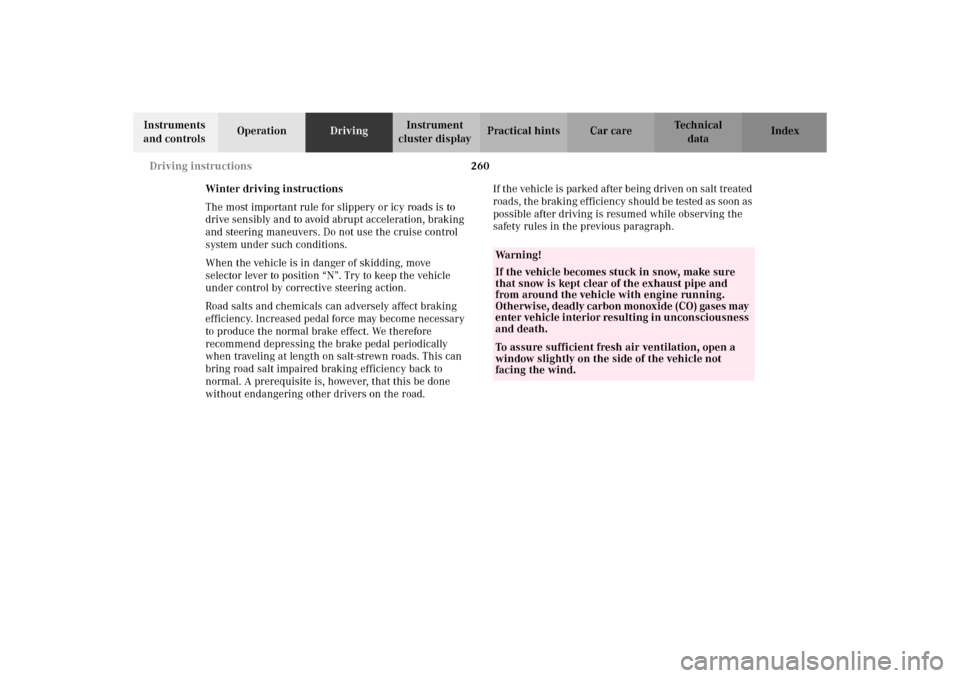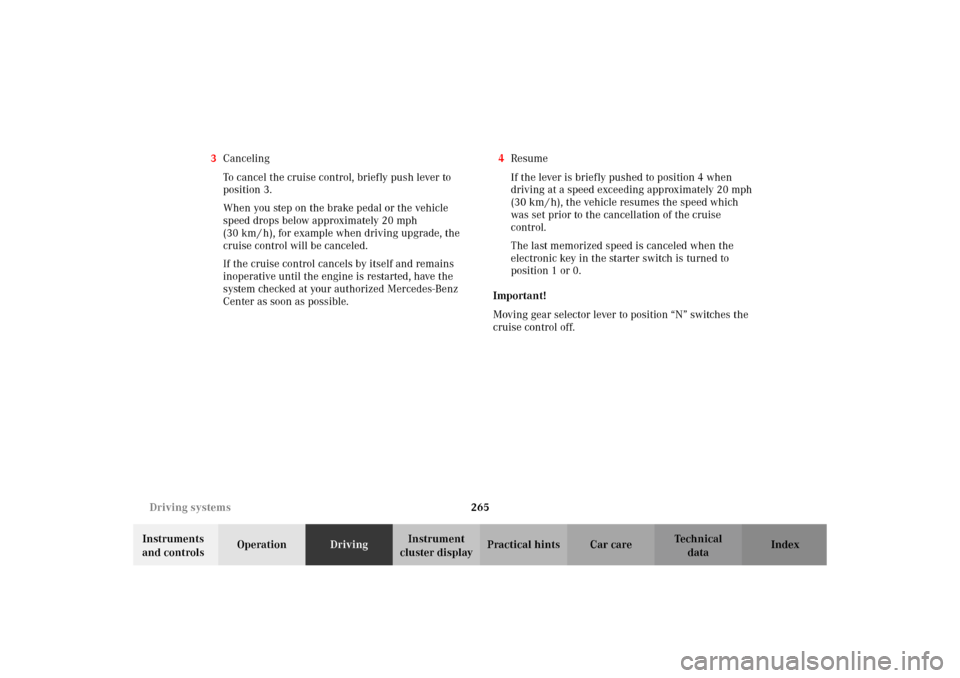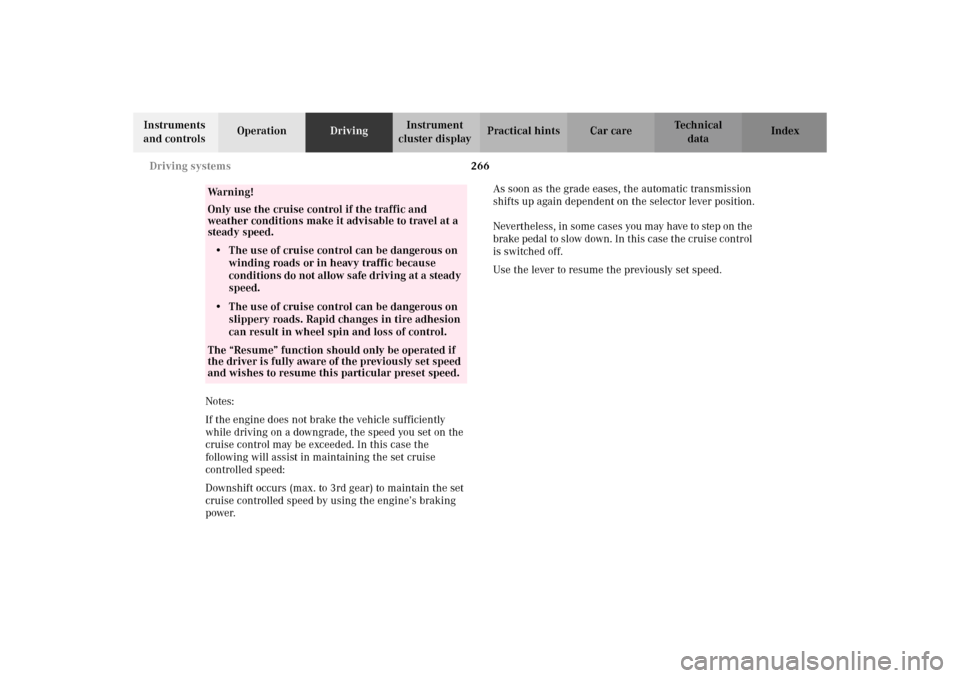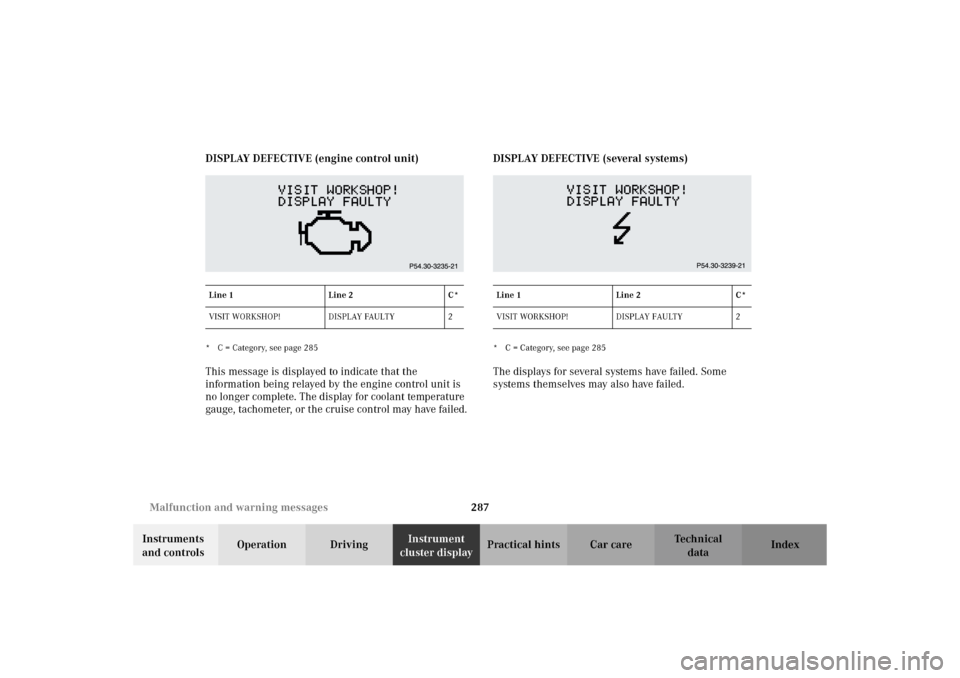2002 MERCEDES-BENZ C320 WAGON cruise control
[x] Cancel search: cruise controlPage 7 of 390

4 Contents
DrivingControl and operation of
radio transmitters .....................226
The first 1 000 miles
(1 500 km) .................................227
Maintenance ...................................227
Tele Aid ...........................................228
Catalytic converter ........................238
Emission control ............................239
Starter switch .................................240
Starting and turning off
the engine ..................................242
Automatic transmission ...............243
Parking brake .................................252
Driving instructions ......................253
Drive sensibly – Save Fuel ........253
Drinking and driving .................253
Pedals ...........................................253
Power assistance ........................254
Brakes ..........................................254
Driving off ...................................255
Parking ........................................256
Tires .............................................257Snow chains ............................... 259
Winter driving
instructions ................................ 260
Deep water .................................. 262
Passenger compartment ........... 263
Traveling abroad ........................ 263
Cruise control ................................ 264
Brake assist system (BAS) ............ 267
Antilock brake system
(ABS) .......................................... 268
Electronic stability program
(ESP) ........................................... 270
What you should know
at the gas station .......................274
Check regularly and
before a long trip .......................276
Instrument cluster displayMalfunction and indicator lamps in
the instrument cluster ............. 278
On-board diagnostic system ........ 278
Check engine malfunction
indicator lamp ............................ 278
Brake warning lamp .................. 280Supplemental restraint system
(SRS) indicator lamp .................. 281
Fuel reserve warning .................282
ABS malfunction
indicator lamp .............................283
Electronic stability program
(ESP) — warning lamp ...............284
Seat belt nonusage
warning lamp ............................284
Malfunction and indicator
lamp in the center console ......284
AIRBAG OFF indicator lamp .....284
Malfunction and warning
messages in the
multifunction display ...............285
DISPLAY DEFECTIVE ................287
BATTERY / ALTERNATOR ........288
ANTILOCK BRAKE SYSTEM ....289
BRAKE ASSIST ...........................289
BRAKE PAD WEAR ....................290
BRAKE FLUID .............................290
PARKING BRAKE ....................... 291
SEAT BELT SYSTEM ................... 291
S203.book Seite 4 Freitag, 19. Oktober 2001 1:25 13
Page 26 of 390

23 Instruments and controls
Te ch n i c a l
data Instruments
and controlsOperation DrivingInstrument
cluster displayPractical hints Car care Index 1Hood lock release, see page 311
2Parking brake pedal, see page 252
3Parking brake release, see page 252
4Exterior lamp switch, see page 137
5Combination switch, see page 142
6Exterior mirror adjustment switch, see page 85
7Headlamp washer button, see page 141
8Cruise control switch, see page 2649Multifunction steering wheel, see page 96
Horn (with electronic key in starter switch
position 1 or 2)
10Instrument cluster, see page 92
11Voice recognition system switch, see separate
operating instructions
12Starter switch, see page 240
13Glove box lid release, see page 195
14Glove box lock, see page 195
S203.book Seite 23 Freitag, 19. Oktober 2001 1:25 13
Page 228 of 390

225 Contents - Driving
Te ch n i c a l
data Instruments
and controlsOperationDrivingInstrument
cluster displayPractical hints Car care Index
DrivingControl and operation of
radio transmitters .....................226
The first 1 000 miles
(1 500 km) .................................227
Maintenance ...................................227
Tele Aid ...........................................228
Catalytic converter ........................238
Emission control ............................239
Starter switch .................................240
Starting and turning off
the engine ..................................242
Automatic transmission ...............243
Parking brake .................................252Driving instructions ...................... 253
Drive sensibly – Save Fuel ....... 253
Drinking and driving ................ 253
Pedals .......................................... 253
Power assistance ........................ 254
Brakes .......................................... 254
Driving off ................................... 255
Parking ........................................ 256
Tires ............................................. 257
Snow chains ............................... 259
Winter driving
instructions ................................ 260
Deep water .................................. 262
Passenger compartment ........... 263
Traveling abroad ........................ 263Cruise control .................................264
Brake assist system (BAS) ............267
Antilock brake system
(ABS) ...........................................268
Electronic stability program
(ESP) ...........................................270
What you should know
at the gas station ....................... 274
Check regularly and
before a long trip ...................... 276
S203.book Seite 225 Freitag, 19. Oktober 2001 1:25 13
Page 263 of 390

260 Driving instructions
Te ch n i c a l
data Instruments
and controlsOperationDrivingInstrument
cluster displayPractical hints Car care Index
Winter driving instructions
The most important rule for slippery or icy roads is to
drive sensibly and to avoid abrupt acceleration, braking
and steering maneuvers. Do not use the cruise control
system under such conditions.
When the vehicle is in danger of skidding, move
selector lever to position “N”. Try to keep the vehicle
under control by corrective steering action.
Road salts and chemicals can adversely affect braking
efficiency. Increased pedal force may become necessary
to produce the normal brake effect. We therefore
recommend depressing the brake pedal periodically
when traveling at length on salt-strewn roads. This can
bring road salt impaired braking efficiency back to
normal. A prerequisite is, however, that this be done
without endangering other drivers on the road.If the vehicle is parked af ter being driven on salt treated
roads, the braking ef f iciency should be tested as soon as
possible after driving is resumed while observing the
safety rules in the previous paragraph.
Wa r n i n g !
If the vehicle becomes stuck in snow, make sure
that snow is kept clear of the exhaust pipe and
from around the vehicle with engine running.
O t h e rw i s e , d e a d ly c a r b o n m o n ox i d e ( CO ) ga s e s m ay
enter vehicle interior resulting in unconsciousness
and death.To assure sufficient fresh air ventilation, open a
window slightly on the side of the vehicle not
facing the wind.
S203.book Seite 260 Freitag, 19. Oktober 2001 1:25 13
Page 267 of 390

264 Driving systems
Te ch n i c a l
data Instruments
and controlsOperationDrivingInstrument
cluster displayPractical hints Car care Index
Cruise control
The cruise control allows you to drive in a more relaxed
manner, for example over long distances, as it
automatically maintains the set speed by actively
regulating the throttle setting.
Any given speed above approximately 20 mph
(30 km / h) can be maintained with the cruise control by
operating the lever.1Accelerate and set:
Lift lever briefly to set speed. Hold lever up to
accelerate.
2Decelerate and set:
Depress lever briefly to set speed.
Hold lever down to decelerate.
Normally the vehicle is accelerated to the desired
speed with the accelerator.
Speed is set by briefly pushing the lever to
position 1 or 2. The accelerator can then be
released.
The speed can be increased (e.g. for passing) by
using the accelerator. After the accelerator is
released, the previously set speed will be resumed
automatically.
If a set speed is to be increased or decreased
slightly, e. g. to adapt to the traf f ic f low, hold lever in
position 1 or 2 until the desired speed is reached, or
briefly tip the lever in the appropriate direction for
increases or decreases in 0.6 mph (1 km / h)
increments. When the lever is released, the newly
set speed remains.
S203.book Seite 264 Freitag, 19. Oktober 2001 1:25 13
Page 268 of 390

265 Driving systems
Te ch n i c a l
data Instruments
and controlsOperationDrivingInstrument
cluster displayPractical hints Car care Index 3Canceling
To cancel the cruise control, briefly push lever to
position 3.
When you step on the brake pedal or the vehicle
speed drops below approximately 20 mph
(30 km / h), for example when driving upgrade, the
cruise control will be canceled.
If the cruise control cancels by itself and remains
inoperative until the engine is restarted, have the
system checked at your authorized Mercedes-Benz
Center as soon as possible.4Resume
If the lever is briefly pushed to position 4 when
driving at a speed exceeding approximately 20 mph
(30 km / h), the vehicle resumes the speed which
was set prior to the cancellation of the cruise
control.
The last memorized speed is canceled when the
electronic key in the starter switch is turned to
position 1 or 0.
Important!
Moving gear selector lever to position “N” switches the
cruise control off.
S203.book Seite 265 Freitag, 19. Oktober 2001 1:25 13
Page 269 of 390

266 Driving systems
Te ch n i c a l
data Instruments
and controlsOperationDrivingInstrument
cluster displayPractical hints Car care Index
Notes:
If the engine does not brake the vehicle sufficiently
while driving on a downgrade, the speed you set on the
cruise control may be exceeded. In this case the
following will assist in maintaining the set cruise
controlled speed:
Downshift occurs (max. to 3rd gear) to maintain the set
cruise controlled speed by using the engine’s braking
power.As soon as the grade eases, the automatic transmission
shifts up again dependent on the selector lever position.
Nevertheless, in some cases you may have to step on the
brake pedal to slow down. In this case the cruise control
is switched off.
Use the lever to resume the previously set speed.
Wa r n i n g !
Only use the cruise control if the traffic and
weather conditions make it advisable to travel at a
steady speed.• The use of cruise control can be dangerous on
winding roads or in heavy traffic because
conditions do not allow safe driving at a steady
speed.
• The use of cruise control can be dangerous on
slippery roads. Rapid changes in tire adhesion
can result in wheel spin and loss of control.The “Resume” function should only be operated if
the driver is fully aware of the previously set speed
and wishes to resume this particular preset speed.
S203.book Seite 266 Freitag, 19. Oktober 2001 1:25 13
Page 290 of 390

287 Malfunction and warning messages
Te ch n i c a l
data Instruments
and controlsOperation DrivingInstrument
cluster displayPractical hints Car care Index DISPLAY DEFECTIVE (engine control unit)
* C = Category, see page 285This message is displayed to indicate that the
information being relayed by the engine control unit is
no longer complete. The display for coolant temperature
gauge, tachometer, or the cruise control may have failed.DISPLAY DEFECTIVE (several systems)
* C = Category, see page 285The displays for several systems have failed. Some
systems themselves may also have failed.
Line 1 Line 2 C*
VISIT WORKSHOP! DISPLAY FAULTY 2
Line 1 Line 2 C*
VISIT WORKSHOP! DISPLAY FAULTY 2
S203.book Seite 287 Freitag, 19. Oktober 2001 1:25 13